Breakthrough Oder
On April 17, the armies of the 1st Belorussian Front resumed their offensive with the goal of breaking through the second line of German defense. All day fierce battles. The German command, in order to thwart the Soviet offensive, threw into the counterattack the 25th Motorized Division, the Kurmarck Motorized Division and tank Müncheberg Division. The Germans tried to give a decisive battle near Berlin, so as not to let our troops into the capital. As a result, the battle of April 17 was crucial for the battle of Berlin.
Part of the forces of the Soviet army at night tried to improve the situation and penetrate the enemy's defenses. In the morning after the artillery barrage, the main forces of the 1 of the Byelorussian Front went on the offensive everywhere. Troops of the 47 Army Perkhorovich in 8 hour. after the 30-minute artillery preparation went on the attack. During the first half of the day, the Soviet divisions, overcoming the stubborn resistance of the German troops and repelling the attacks of the 25 motorized division, broke through the enemy’s intermediate position, advanced 4-5 km and started a battle for the second line of defense. Heavy fighting followed the strongholds of Vritzen and Kunersdorf. After breaking through the second defense zone, Zhukov ordered the 7 Guards Cavalry Corps to be breached, so that April 18, together with the second Guards Tank Army, develop an offensive to the north and take the north-eastern part of Berlin.
Kuznetsov’s 3 Shock Army, supported by the 9 Guards Tank Corps of the 2 Guards Tank Army, Bogdanov also continued the offensive in 8 hours. German troops, including units of the 25 Motorized Division, stubbornly resisted in the Kunersdorf area. Our troops broke through the enemy’s intermediate position, forced the Fridlandshtorm Canal, wedged the defense into the second lane, moving towards the end of the day on 6-8 km.
The troops of the 5th shock army of Berzarin, with the support of the 12th Guards Tank and 1st Mechanized Corps, went on the offensive at 10 o’clock. 10 min., After a 20-minute artillery preparation. The most stubborn battles took place in the offensive zone of the 32nd and 9th rifle corps and the mobile units supporting them. Using fords and improvised materials, Soviet soldiers selflessly crossed the Alt Oder, stormed the strongholds of Platkov and Guz. By the end of the day, our troops advanced 11-13 km. The 26th Guards Rifle Corps also operated successfully. At night, our troops reached the river. Alt Oder and after a powerful arthur, broke through the second line of defense of the enemy. By the end of the day, the corps had advanced 11 km. The success of the 5th Assault and the 2nd Guards Tank Army was helped by the strikes of our assault and bomber aviation, which struck at strong points and positions of the enemy. By the end of the day, our troops broke through the second line of defense.
Special attention was paid to the preparation of an offensive in the offensive zone of the 8 Guards Army, which had stormed the Seelow Heights. All night Soviet artillery changed its position. Only long-range guns remained in place. The start of the artillery preparation was scheduled for the 9 hour. 45 min. The main focus of the bomber and assault aircraft was directed to this offensive zone. I must say that the actions of our aircraft on this day were limited due to bad weather conditions. During the day, 1658 was made sorties, of which around 800 night.
In 10 hour. 15 min. The 8-th Guards Army, with the support of the 1-th Guards Tank Army, resumed the offensive. The Germans, relying on a powerful defense, actively defended themselves, went over to counterattacks with the support of groups of tanks on 10-12 machines. The 4 th Guards Rifle Corps of General V. A. Glazunov, with the support of the 11 th Guards Tank Corps of Colonel A. Kh. Babajanyan, in a brutal battle stormed the city of Seelow. By the end of the day, the corps broke through the second lane of defense, advancing 8 km.
During the assault on the Seelow Heights, the commander of the 3 Battalion of the 172 Guards Rifle Regiment (57 Guards Rifle Division) captain Nikolai Nikolayevich Chusovskaya distinguished himself. Combat Chusovskaya was one of the first to break into Seelow Heights, and personally destroyed several enemy soldiers in hand-to-hand combat. The battalion Chusovskogo took part in the storming of Seelow. After a stubborn battle, the north-eastern outskirts of the city were cleared. 148 soldiers and officers were killed, 48 people were captured, Soviet soldiers destroyed a mortar battery, 12 firing points, a tank and 2 self-propelled guns. With further advance to Berlin, the Chusovskys battalion fell into a semi-circle. Using the trophy weapon (grenades and faustprony), our fighters repulsed several enemy counterattacks. Later the battalion took part in the storming of Berlin. For the skillful command of the battalion and the courage and heroism shown by the guards to captain Nikolay Nikolayevich Chusovsky, they were given the title Hero of the Soviet Union.
After Seelow’s fall, the German command, in order to close the gap between the 56 tank corps and the 11 SS army corps, deployed the Kurmar motorized division into the battle.
The 29-th Guards Rifle Corps of General A. D. Shemenkov and the main forces of the 11-th Guards Tank Corps, using the success of the 4-th Guards Corps, broke through the German defenses south of Seelow. As a result, the 29 Corps overcame the second line of defense and advanced by 2-4 km. 28-th Guards Rifle Corps of General A. I. Ryzhov, with the support of 8-th Guards Mechanized Corps I. Dremov, breaking the enemy's resistance and repelling his attacks, took the support point Dolgelin, wedged in the second line of defense. As a result, on April 17, the troops of the 8 Guards Army broke through the strongest enemy positions in the second line of defense, took a number of important strongholds. "The key to Berlin" - Seelow Heights, were captured.
On the flanks, the offensive of the 1 of the Byelorussian Front also developed successfully. In 6 hour. 30 min. went on the offensive 61-I army. Our troops successfully crossed the Oder and captured a foothold. Polish troops resumed after a short artillery preparation in the 8 hour. By the end of the day of the 1 Division, the Polish Army advanced 4-7 km.
The units of the 69 Army, resumed the offensive in the 10 hour, after the 30-minute artillery preparation. In the course of a stubborn battle, Malnov stronghold was captured In some areas, our troops penetrated into the enemy defense on 1-2 km and by the end of the day fought for the second line of defense. The 33 Army launched its offensive at 11 hour. after the 30 minute artillery preparation. By the end of the day, our troops in different directions advanced 1-5 km.
Thus, on April 17, the troops of the 1 of the Belorussian Front achieved the greatest success in the offensive zone of the main attack force (47-I, 3-I, 5-I shock and 8-I Guards armies). Our troops broke through the powerful second line of defense, occupied the Seelow Heights. Two intermediate rear defensive lines were also hacked. Soviet troops advanced 6-13 km. As a result, it was only on the second day that the operations were able to solve the task that they planned to perform on the first day. The rate of attack was lower than planned. 1-I and 2-I Guards tank armies could not tear myself away from the infantry and begin a breakthrough into the operational depth. Meanwhile, the troops of the 1 of the Ukrainian Front were completing a breakthrough of the enemy defenses. Therefore Stavka demanded from Zhukov more energetic measures to break through the German defense. In addition, to help the Belarusian Front 1, he ordered the commander of the Ukrainian Front 1, Konev, to immediately begin carrying out the attack of tank armies on Berlin from the south. And the troops of the 2 of the Byelorussian Front were to go on the offensive on April 20, bypassing Berlin from the north. All this was supposed to weaken the German resistance in the center, to divert the German command to other directions.
In turn, Zhukov ordered army commanders to accelerate the pace of the offensive. They decided to bring the artillery close to the advanced infantry orders (including high-powered artillery). Artillery had to massively support infantry and tanks in the directions of the breakthrough.
During two days of brutal battles, German troops suffered huge losses: 9 divisions defending the Oder line lost up to 80% of personnel, almost the entire material and technical part, that is, was defeated. Therefore, from April 18, the German command began to introduce into the battle new reserves from the Berlin garrison - the Hitler Youth and Dora tank battalions; from the 3 Tank Army - the 23 th Netherlands Netherlands. In addition, various separate battalions, teams, training units, schools, etc., that had come from Berlin, were thrown into battle.
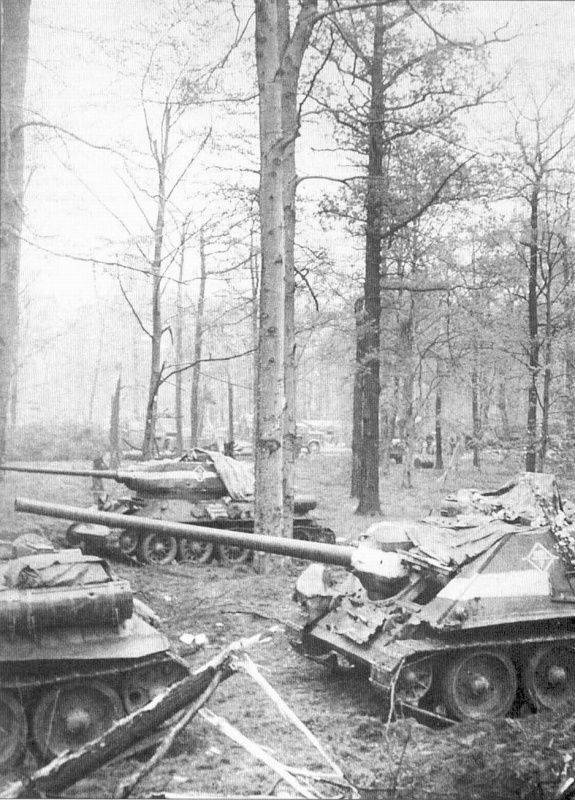
Soviet SAU SU-100 and T-34-85 tanks near Berlin
18 April
In the morning the main attack force of the front continued the offensive. The 47 Army resumed its offensive at the 10 hour. after 40 minute artillery preparation. All day, the three army corps were engaged in a stubborn battle for the Vritzen and Veve strongholds. By the end of the day, the army advanced by 1-3 km, completing the breakthrough of most of the second line of defense. 7-th Guards Corpus failed to enter into a breakthrough, the Germans, holding their strongholds, continued to hold intermediate positions, their defense did not collapse.
The troops of the 3 shock and 2 guards tank armies advanced by 4-6 km, took a large stronghold Kunersdorf. The breakthrough of the enemy’s second defense zone was completed, but the tank army was not able to tear itself away from the infantry that day either. 5-I shock army, beating off enemy counterattacks and overcoming solid blockages in the forest, advanced by 3 km. At the turn of Reichenberg, at Münchehofe, our troops faced stubborn resistance from the Hitler Youth Tank Fighter Brigade and could not get further. The main forces of the 12 Guards Tank Corps, from adverse terrain conditions (forests and marshes), were transferred to the Batslova region. Having crossed the Stobber River, the 1 Mechanic Corps and the 12 Guards Tank Corps took the Ringenwalde stronghold during a stubborn battle. The Germans, trying to prevent a breakthrough of Soviet tanks from the forest into the open, fiercely fought.
8-I Guards Army and 1-I Guards Army resumed the offensive in 7 hours, after a short artillery preparation. The Germans continued to resist stubbornly, deploying an 23 motorized division, a Dora brigade, and a number of individual battalions and subunits in the east of Müncheberg. During the day, our troops repelled 14 German counterattacks. The right flank of the army, despite the German attacks, continued to advance and in a day advanced to 8 km. The left-handed 28-th Guards Rifle Corps continued to fight in the second line of defense, with a slight advance. This was due to the unfavorable nature of the hilly terrain with a large number of lakes and channels.
On the northern flank, the 61-I army continued its advance on a narrow sector of the front from the mouth of the r. Alt Oder to Neu Glitzen. During the day, our troops advanced 3 km, reaching the Neuenhagen area. Polish troops continued their offensive in difficult terrain, rugged by numerous canals and marshes. During the day 1-I army of the Polish Army passed 2-4 km. Thanks to the success of the neighboring 47 Army, the Polish left flank reached the second line of enemy defenses. On the southern flank of the front 69-I army led heavy battles with the enemy and almost did not move. The 33 Army, continuing to advance in hilly and wooded areas, fighting off German counterattacks, had little progress. The 16 th rifle corps of General E. V. Dobrovolsky and the 62 th rifle corps of General Ya. S. Vorobyov reached the Markendorf line, Frankfurter-Höhe.
Source: Isaev A.V. Berlin 45
Frontal aviation 18 April focused on the destruction of strongholds and the destruction of clusters of manpower and equipment of the enemy. The strikes were also inflicted on the strong points of the third line of defense located in the rear. Air strikes were inflicted on the areas of Vritshen, Sternbek, Bukov, Müncheberg, Heinersdorf, etc. During the day our planes made 4276 sorties, shot down an enemy's 161 car.
Thus, 18 of April, the main shock grouping of the front continued to advance to the west, overcame two intermediate defensive positions of the enemy. The Germans introduced reserves into the battle - several divisions and brigades, which retained the extremely fierce nature of the fighting in the Berlin sector. The mobile units of the front, due to fierce resistance of the enemy and difficult terrain for armored vehicles, could not tear themselves away from the infantry.
The front command again demanded an acceleration of the pace of the offensive. Taking into account the fact that our troops achieved the greatest success on the right wing of the main attack force, it was decided that the troops of the 3 and 5 shock, 2 of the Guards Tank Armies would concentrate their efforts towards the north-eastern outskirts of Berlin. The troops of the 47 Army and the 9 Guards Tank Corps were to begin to cover the German capital from the north and northwest. The troops of the 8-th Guards and 1-th tank armies still attacked Berlin from the east.
The German command left no hope of stopping the Soviet offensive. 18 April Adolf Hitler issued a decree stating that the Berlin Defensive Area is part of the 9 Army Front. All the forces of the garrison of Berlin, including the battalions of the Volkssturm, were deployed to the third (rear) line of defense, where Soviet forces tried to stop. On the night of April 19, the reserves began to be thrown into the offensive zone of the 1 of the Byelorussian Front. A guard regiment, a machine gun serf battalion, 2 security and 2 police battalions, 22 air defense units, 1 brigade and Volkssturm battalion were transferred from Berlin; from the 21 Tank Army - the 3 th SS motorized division "Nordland".
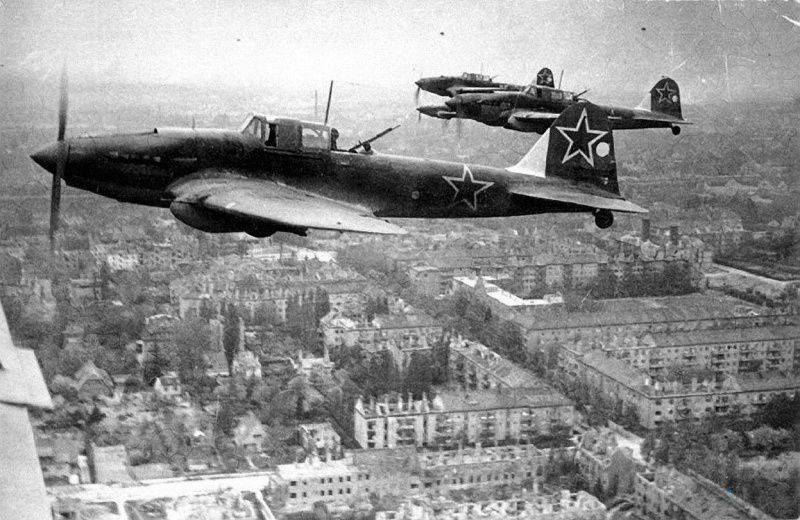
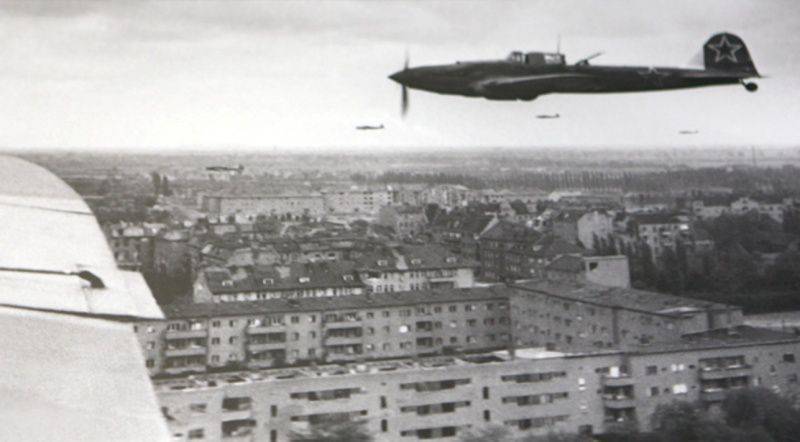
Soviet Il-2 attack aircraft from the 4 Air Force in the sky over Berlin
Completion of the breakthrough of the Oder defense line
The 19 of April, the strike force of the 1 of the Belorussian Front, completed the breakthrough of the Oder defense line of the enemy. 19 April 1945 The 47 Army and the 9 Guards Tank Corps in the Sternbek area broke through the enemy’s third line of defense and advanced towards 4-12 km in different directions by the end of the day. The troops of the 3 shock army, supported by the 1 mechanized corps, fought all night and on April XN, after heavy fighting, broke through the third line of defense on the entire front, advancing 19 km.
The 5 shock army, in conjunction with the 12 Guards Tank Corps, broke the resistance of the SS 11 Motorized Division, broke through the third line of defense in the Grunov-Bukov sector and advanced 9 km in a day. In the offensive zone of the 8 Guards Army, particularly stubborn battles were fought for the Müncheberg stronghold. In the morning, our troops conducted reconnaissance in force. In 12 hour. 30 min. After the 30-minute artillery preparation, the 4 Guards Corps with parts of the 11 Tank Corps and then the 29 Corps went on the offensive. The army of Chuikov in different directions advanced by 5-10 km, captured Müncheberg and started a battle in the third line of defense. However, the left flank of the 8-th Guards Army (28-th Guards Rifle Corps), advancing in difficult terrain, advanced only on 1 km, continuing the battle in the second line of defense of the enemy.
The troops of the 61 Army battled for the expansion of the bridgehead and advanced slightly, reaching the Oderberg line, the Gabs. The Polish army forced the left flank of the river. Alt Oder and advanced on 2-3 km, reached the line Neugaul, Vritzen. On the left flank of the 1-I Polish army broke through the second line of defense of the enemy. At night, the Alt Oder forced the main forces of the Polish army.
The southern strike force of the front continued to conduct heavy fighting, breaking through the German defenses. The troops of the 69 Army, reflecting the German counterattacks, advanced to 3-4 km, took several strongholds and broke through the second line of defense. The troops of the 33 Army made a regrouping of forces and repelled the attacks of the enemy. The 129 and 283 rifle divisions eliminated the enemy's bridgehead on the right bank of the Oder (the Germans withdrew the main forces of April 18) and captured the eastern part of Frankfurt an der Oder.
Soviet aviation 19 April struck at the third line of defense of the enemy. Soviet aircraft made 4398 sorties, shot down 112 German aircraft.
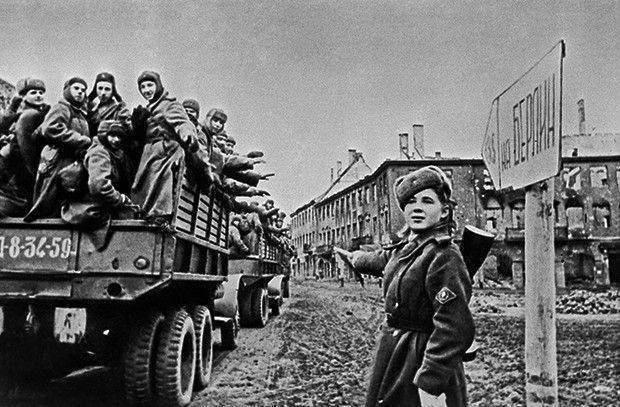
Results
By the end of April 19, Soviet troops had broken through the first, second and third enemy defensive lines on the 70-kilometer front stretch from the mouth of the Alt Oder to Vüste-Kunersdorf. In four days of stubborn fighting, our troops advanced 30 km. The enemy’s bridgehead was liquidated on the right bank of the Oder in the Frankfurt-on-Oder region. The German Oder frontier troops of the main attack group could break through only on the fourth day of the operation, although according to the original plan it was planned to break through on the second day of the offensive.
The main defensive lines of the enemy on the way to Berlin fell. Now it was necessary to cut off the main forces of the 9 Army from Berlin and accelerate the movement in order to rush into the German capital on the shoulders of the enemy and simultaneously with part of the forces to sweep the city from the north.
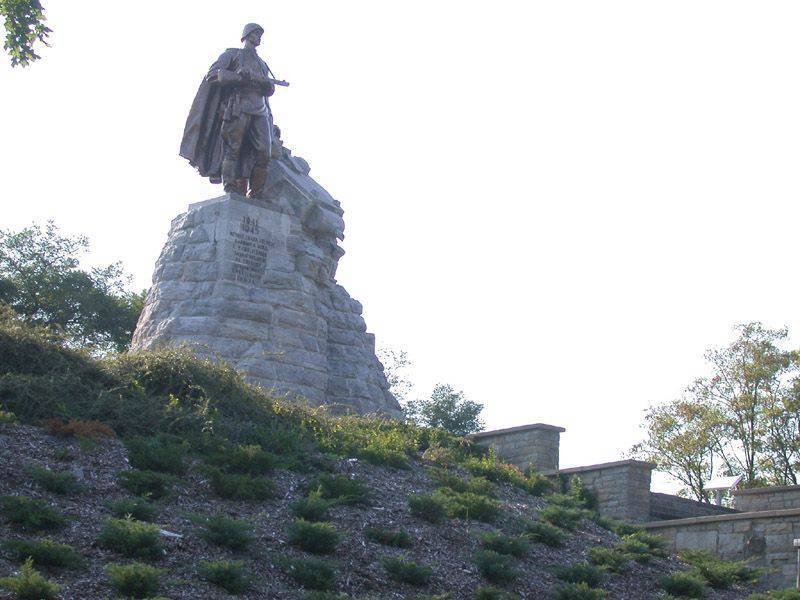
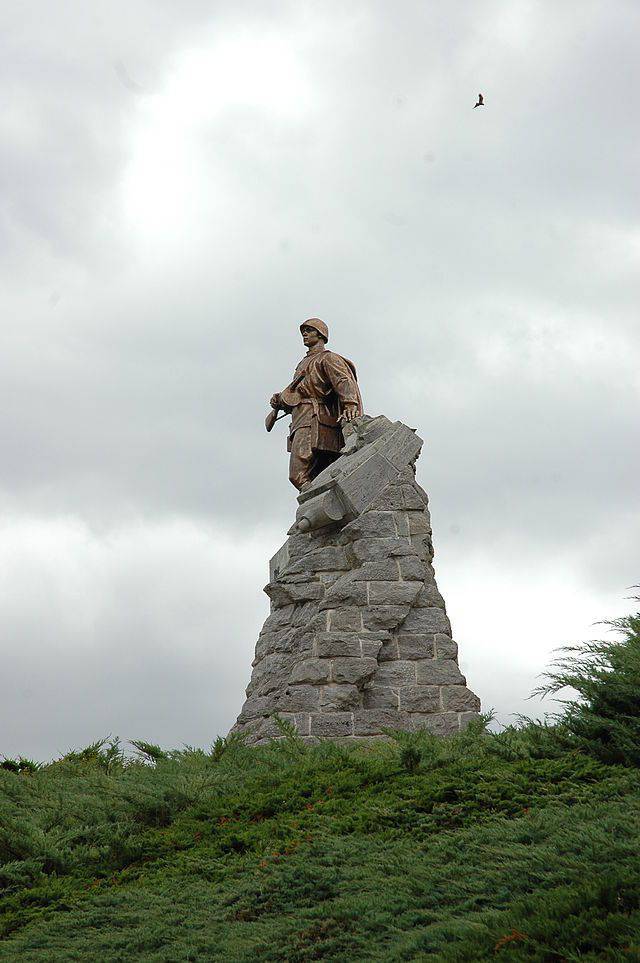
Monument to Soviet soldiers on the Seelow Heights by L. E. Kerbel
To be continued ...
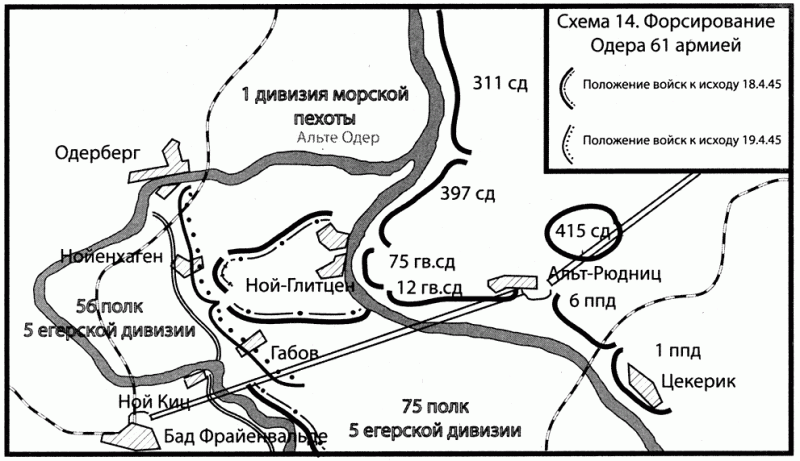
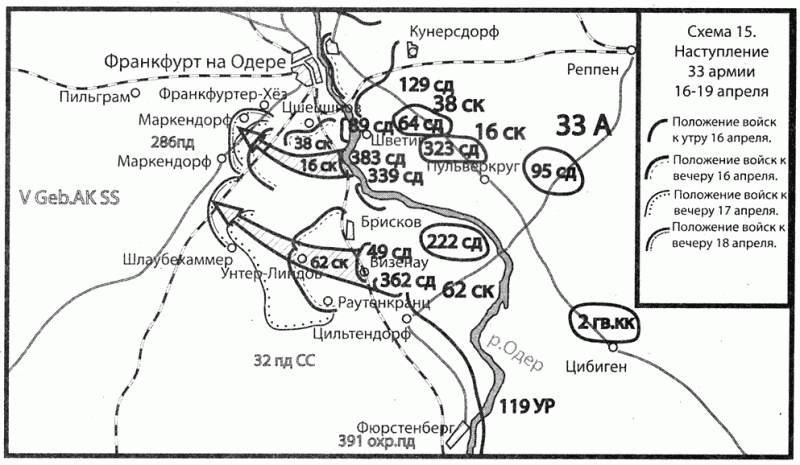
Information